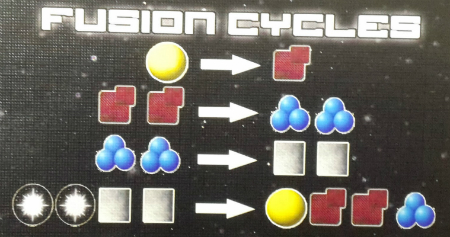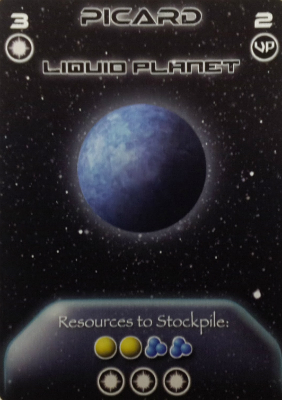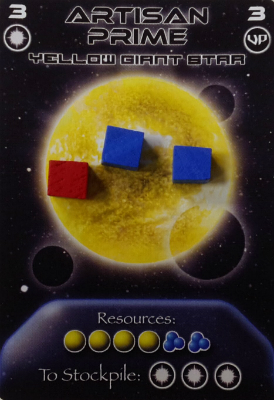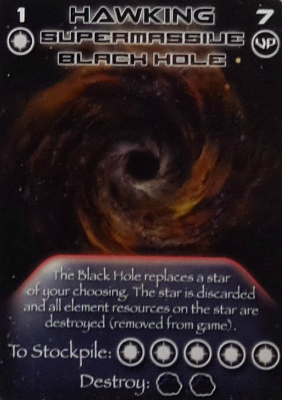“Hell of a thing sending another universe to certain doom. Lots of fun, though. Makes a man feel big.” – Zapp Brannigan
The Premise
In Eons, players experience the entire lifespan of the universe firsthand. Players take on the roles of Cosmic Architects – beings of immense power and will – as they compete to guide the universe’s trajectory. Players create planets, stars, and other cosmic bodies, but the system is not capable of infinite expansion. Stars and planets will meet their end. The Cosmic Architects must balance their desire for points against provoking one another, as each destruction spirals the universe ever closer to final entropy.
The Rules
Euros are not known for being quick to set up, but Eons doesn’t require much time or space. The game is mainly comprised of a pool of resources and a deck of Cosmic cards. There are six resources: Hydrogen, Carbon, Oxygen, Iron, and Uranium make up the elemental building blocks for all cosmic bodies such as planets, stars and nebulae (simplified from the real universe of course). The sixth resource is Essence, which represents the power of the Cosmic Architects to create – or destroy – things in the universe.
Cosmic cards are a players options for the round and consist of either cosmic bodies to be created, items to attach to planets (life and civilization), or a means of destroying said cosmic bodies (such as supernovas or asteroid impacts).
The End Is Near
The game board also contains the Entropy Track, depicting currently how far the universe is from entropy and the end of the game.
The first player is determined randomly – though we say feel free to come up with one space or science related. Each player receives seven Cosmos cards, some resources, and a Focus Token.
The turn structure in Eons consists of five phases: Create, Account, Plan, Fusion, Purchase. During Creation, players spend resources creating one more more cosmic bodies and/or playing cosmic events.
In every case except stars, a player simply pays the resource costs. If it is a star, the resources are placed onto the card instead. Each star contains slots available for planets to orbit them. Planets are only scored if there are enough open slots among stars that player controls. (For example, if a player has a Red Dwarf star with one slot, only one planet will count towards scoring.)
Here, players may also play or move their Focus Token on any cosmic body they have. It serves two purposes:
- That cosmic body is immune to other players.
- If placed on a planet, that planet will generate Essence and VP regardless of whether a star is available.
In Account, players collect Essence and adjust their VP up or down. This also sets the turn order for the round. In Plan, players may discard cards from their hand and draw back up to seven.

The four fusion options available.
Next is Fusion, where players have each star of theirs undergo one of several fusion processes. In reverse turn order, players exchange elements from the star and the resource pool. New elements are either placed back on the star for use next round and/or added to the player’s supply. If a star is unable to undergo fusion, it dies.
Lastly, players move to Purchase, where, in reverse order, they may spend Essence for elements. Then the cycle begins anew
Unlike most Euro games, rounds are not fixed in Eons. The game’s length is instead determined by the Entropy Track. Any time a cosmic body dies, the Entropy Track ticks down one. Once Entopy reaches zero, play continues through a final Account phase. At that point, the player with the most VP is determined to be the most successful Cosmic Architect and can retire happy.
The losers . . .don’t have to worry about anything. The universe just ended.
We Are The Not-Gods
|
Fun with Science! |
| Eons has a number of mechanics based on real-world concepts:In 1789, French scientist Antoine Lavoisier established the Law of Conservation of Mass – that mass is neither created nor destroyed in a chemical reaction.In the 1830s and 1840s, German scientist Julius Mayer and English scientists James Joule (among others) independently came up the Law of Conservation of Energy – that energy is not created or destroyed, only changed.
The Law of Conservation of Energy later became the first Law of Thermodynamics. In 1905, a German-born scientist submitted that matter and energy are interchangeable, in what became known as the theory of special relativity. You know this as the equation E=MC^2. The man was Albert Einstein, and that theorm is one of the pillars of modern physics. The theory of the universe reaching a state where there is so little entropy (the breaking down of a system into greater chaos and less available work) has been around since the mid 1800’s. It is known as the Heat Death of the Universe. |
However, many Euros also tend to have a pretty generic theme tacked on to them as to give the game some kind of agency, some purpose. While many people like games strictly on mechanics alone, most people prefer one with at least the illusion of flavor if they’re going to be moving little wooden blocks around for 90 minutes.
Make no mistake about Eons: it is a Euro game. It’s apparent from the onset, though, is that Eons was very evidently was built as a top-down design concept, where the theme was paramount to the game’s existence. Eons is about the vast cosmos of space, and a number of the mechanics were cleverly designed with a real-world understanding of the science behind it.
The most telling of these is a fixed resource system. Players must contend with the fact that there are only so many resources available in order to build new cosmic bodies. As players put out more, there are fewer and fewer elements for stars to perform fusion, inevitably resulting in their demise.
Indeed, another thematically-relevant mechanic is fusion itself. Different stars require different starting elements, depending on their type and size. As stars undergo fusion, generating heavier and heavier elements, the results can either be emitted into space (your supply), or they can be retained to continue the cycle anew.
Granted, there are some liberties taken for the purposes of fun gameplay, and several are even mentioned in the rules as if the designers felt bad at having to trade the science behind Eons for a more enjoyable experience. Blowing up a star, for example, does not affect the health or well-being of any planets beyond the ability for them to score VP / Essence, and even without a star, as an ethereal Cosmic Architect you can still will a planet to function through the Focus Token. Moreover, the fusion cycle has a fission action instead to keep the star wholly sustainable, and that fact even garners its own sidebar.

“I believe I have seen the Overseer. He is called ‘The Picard.'”
Those things aside, space-loving Immersionists will appreciate the universe-building atmosphere. Playing as not-gods, they’ll likely amuse themselves by coming up with silly planetary backstories during the game, such as having three aquatic planets means they clearly favor merpeople. Even though many of the planets and stars have the same pictures, each cosmic body is uniquely named. Many are even named after famous science and science-fiction personalities, which should appeal to them all the more.
From a gaming standpoint, this makes for a wonderfully tight economic model. The more your area grows, the resources available to everyone else decreases. The larger the overall universe becomes, the more likely that stars are going to start dying due to scarcity of elements – or players are going to start destroying them.
Additionally, since both the Fusion phase and Purchase phase are done in reverse order, the harder it is for the lead player to stay there without incurring losses. This creates a taut ebb-and-flow feeling when playing, such that it’s often difficult for one player to become a runaway winner. And if someone does pull ahead, there are enough star-killing, planet-smashing cards at players’ disposal to pull them back in line. All of this makes for games that are often down to the wire for final scoring, with players usually pretty close to one another.
The Uraniums of Castamere
As great a job Eons does at presenting its theme, some still may have a tough time getting beyond the surface aspects of the game. A quick glance could give new players pause as the game board contains a lot of black, brown, and dark yellow tones to it (it is space after all), and the rules insert may seem congested for only being a couple pages long. However, a closer inspection reveals that the game has a lot of substantive qualities to it. The only time the color scheme matters is with some of the darker player markers blending into the board. While we do agree that the rules presentation could be a bit cleaner, there are rarely areas of gameplay confusion because of it.

This player better hope there’s two iron elements available.
That said, Eons is not a game for everyone. Eons is a Resource Management game to the core. With players competing for a finite amount of resources, Eons requires keeping track of what other players are doing and what your next steps are to ensure your stars continue to twinkle and planets to revolve. Unsurprisingly, this means you should count out Socializers, as this is not their type of game.
By the exact same logic, this is precisely the style of game Tacticians gravitate towards. Eons is an economic puzzle to figure out, and that’s precisely the sort of quantum entanglement they like. The element market does shift from round to round, creating some short term stalls, but between being able to discard unnecessary cards during Planning and carefully managing available resources, it isn’t impossible to plan marginally ahead.
Strikers too will find enjoyment in Eons. The game ends due to cosmic bodies being destroyed, so the choice becomes whether those are your own or someone else’s. Eons can be played as passively or aggressively as your group prefers, opting to either utilize the array of destruction cards or discard them for more planets and stars. Strikers won’t be the group waiting around for all the stars to die out on their own, though. A more passive approach extends the life of the game and, if dragged out too much, can make the game start to feel repetitive. The goal is to have the most points at the end after all. If they’re in the lead they may want to (and probably should) speed the endgame up by taking some of your territory out in the process.

Hawking may be worth 7VP, but it comes at a cost.
It becomes understandable, then, to note why Architects are likely to pass on this game. On the surface they should like Eons – you can’t build a bigger civ than a universe. However, their interest lies more on the ‘expansion’ rather than the ‘contraction’ side of the equation. They won’t like their hard-earned territories being easily blown up at the whim of another player – which happens – and they aren’t likely to do it to others. Even when it’s worthwhile to sacrifice one of their cosmic bodies to get another, one-for-one trades are still a loss in their book.
Conversely, Daredevils have the opposite problem. In typical Euro-style game fashion, there is not a lot of room for off-kilter maneuvers in Eons. Their biggest enjoyment out of the game will likely be just eliminating other people’s stuff. Given that finals scores in Eons are often close to begin with, the most sway they’ll usually have in a playthrough is being a kingmaker. Still, while likely amusing to them, that isn’t enough to keep their retention.
The Takeaway
Eons is a fantastic resource management game that scratches the Euro itch in most cases under an hour. It’s refreshing to see a game about space that doesn’t revolve around aliens and spaceships (not that those aren’t cool too), but it’s even more impressive that Eons managed to do it with mechanics that tie into actual scientific concepts. There’s a lot of appeal to building new stars and planets, even with the ever-present threat of them meeting an unfortunate end. Its fixed resource pool creates a tight but fun economic system as players balance their way to the finish line. Don’t let a cursory glance at the game dissuade you from checking this game out. Truly, you’ll likely not see a game about the end of the universe quite so enjoyable as Eons.
Eons is a product of Gamer Nation Studios.
Cardboard Republic Snapshot Scoring (Based on scale of 5):
Artwork: 2.5
Rules Clarity: 3.5
Replay Value: 4
Physical Quality: 3
Overall Score: 4

